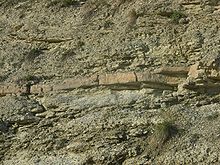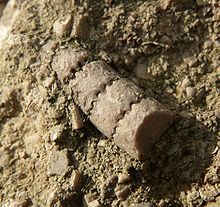- Muschelkalk
-
System Series Stage Age (Ma) European lithostratigraphy Jurassic Lower Hettangian younger Lias Triassic Upper Rhaetian 199.6–203.6 Keuper Norian 203.6–216.5 Carnian 216.5–228.7 Middle Ladinian 228.7–237.0 Muschelkalk Anisian 237.0–245.9 Bunter or Buntsandstein Lower Olenekian 245.9–249.5 Induan 249.5–251.0 Permian Lopingian Changhsingian older Zechstein Major lithostratigraphic units of northwest Europe with the ICS's geologic timescale of the Triassic.[1] The Muschelkalk (German: shellbearing limestone, French: calcaire coquillier) is a sequence of sedimentary rock strata (a lithostratigraphic unit) in the geology of central and western Europe. It has a Middle Triassic (240 to 230 million years) age and forms the middle part of the Germanic Trias, that further consists of the Buntsandstein (lower part) and Keuper (upper part). The Muschelkalk consists of a sequence of limestone and dolostone beds.
In the past the time span in which the Muschelkalk was deposited could also be called Muschelkalk. In modern stratigraphy however, the name only applies to the stratigraphic unit.
Contents
Occurrence
 An outcrop of Muschelkalk cliffs forms the shore of the Wutach River, in the south of Baden-Württemberg.
An outcrop of Muschelkalk cliffs forms the shore of the Wutach River, in the south of Baden-Württemberg.
The name Muschelkalk was first used by German geologist Georg Christian Füchsel (1722-1773). In 1834, Friedrich August von Alberti included it into the Triassic system. The name indicates a characteristic feature of the unit, namely the frequent occurrence of lenticular banks composed of fossil shells. The Muschelkalk is restricted to the subsurface of Germany and adjacent regions as the low countries, the North Sea and parts of Silesia, Poland and Denmark. Outcrops are found in Thuringia, the Harz, Franconia, Hesse, Swabia, and the Saarland and the Alsace.
The Muschelkalk was deposited in a land-locked sea which, in the earlier part of its existence, had only imperfect communications with the more open waters of the Tethys Ocean to the south. The basin in which the Muschelkalk was deposited is called the Germanic Basin.
Sometimes stratigraphic units with the same age from the Alps, southern Europe and even Asia are called Muschelkalk too. Of course these rocks have little in common with the central European Muschelkalk except for similarities in fossil content. The Alpine Muschelkalk differs in many respects from that of Central Europe, and has a closer affinity with the Triassic Tethys realm.
Stratigraphy
The Muschelkalk can be up to 100 meters thick; it is divisible into three subdivisions, of which the upper and lower are pale thin-bedded limestones with greenish-grey marls, the middle group being composed of gypsiferous and saliniferous marls with dolostone. Stylolites are common in all the Muschelkalk limestones.
The lithostratigraphic status of the Muschelkalk differs regionally. In Germany it is considered a group, in the Netherlands a formation.
Germany
 The top of the hard limestone (Schaumkalk) bed forms the top of the Wellenkalk or Lower Muschelkalk and the base of the Orbicularismergel, part of the Karlstadt-Formation. Outcrop near Dörzbach, Baden-Württemberg.
The top of the hard limestone (Schaumkalk) bed forms the top of the Wellenkalk or Lower Muschelkalk and the base of the Orbicularismergel, part of the Karlstadt-Formation. Outcrop near Dörzbach, Baden-Württemberg.
 Fossils of Encrinus liliiforrnis from the Upper Muschelkalk at Kirchberg an der Jagst, Baden-Württemberg.
Fossils of Encrinus liliiforrnis from the Upper Muschelkalk at Kirchberg an der Jagst, Baden-Württemberg.
The German Muschelkalk Group is subdivided into three subgroups: Upper, Middle and Lower Muschelkalk. The Lower Muschelkalk consists mainly of limestone, calcareous marls and clayey marls. Some beds are composed of porous cellular limestone occur (so called Schaumkalk), there are also oolite beds. The Lower Muschelkalk is divided into six formations: Jena-Formation, Rüdersdorf-Formation, Udelfangen-Formation, Freudenstadt-Formation and Eschenbach-Formation. The Lower Muschelkalk is sometimes called Wellenkalk (German: Welle = wave, so called on account of the wavy character of the bedding). In the Saarland and Alsace and northern Eifel, the Lower Muschelkalk has more sandy beds, the Muschelsandstein.
The Middle Muschelkalk or Anbydnite Group consists mainly of evaporites (gypsum, anhydrite and halite) and is divided into three formations: Karlstadt-Formation, Heilbronn-Formation and Diemel-Formation. The facies at the margins of the Germanic Basin is different and these deposits are classified as a separate formation, the Grafenwöhr-Formation, which continues into the Upper Muschelkalk. In the Middle Muschelkalk, weathering can form characteristic cellular dolostone (Zellendolomit).
The Upper Muschelkalk (Hauptmuschelkalk) is similar to the Lower Muschelkalk and consists of regular beds of shelly limestone, marl and dolostone. It is divided into six formations: Trochitenkalk, Meißner-Formation, Irrel-Formation, Gilsdorf-Formation and Warburg-Formation. The lower portion or Trochitenkalk is often composed entirely of the fragmentary stems of Encrinus liliiforrnis; higher up come beds with Ceratites cornpressus, Ceratites nodosus, and Ceratites semipartitus in ascending order. In Swabia and Franconia the highest beds are platy dolomites with Tringonodus sandergensis and the crustacean Bairdia.
Fossil content
In addition to the fossils mentioned above, the following are Muschelkalk forms: Terebratulina vulgaris, Spiriferina Mantzeln and S. hirsute, Myophoria vulgaris, Rhynchotites hirundo, Ceratites Munsteri, Ptychites studeri, Balatonites balatonicus, Aspidura scutellate, Daonella Lommeli, and in the Alpine region several rock-forming Algae, Baciryllium, Gyroporella, Diptopora, etc.
Exploration
The salt beds are worked at Hall, Friedrichshall, Heilbronn, Szczecin and Erfurt. It is from this division that many of the mineral springs of Thuringia and south Germany obtain their saline contents.
References
 This article incorporates text from a publication now in the public domain: Chisholm, Hugh, ed (1911). Encyclopædia Britannica (11th ed.). Cambridge University Press.
This article incorporates text from a publication now in the public domain: Chisholm, Hugh, ed (1911). Encyclopædia Britannica (11th ed.). Cambridge University Press.
- ^ Gradstein et al. (2004)
Categories:- Triassic geologic formations
- Lithostratigraphy
- Geology of Germany
Wikimedia Foundation. 2010.
